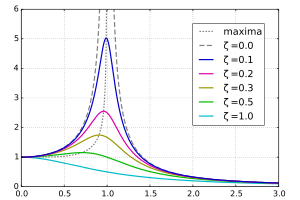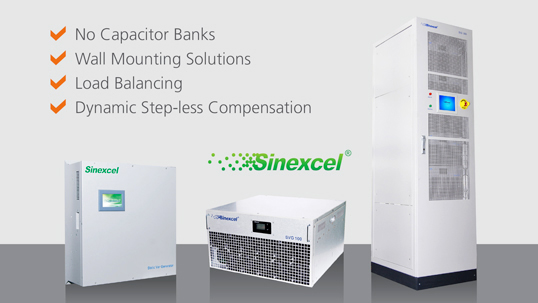Why is Resonance a Problem in Power Factor Correction?
Why is Resonance a Problem in Power Factor Correction?
Harmonic resonance is a common problem that occurs when Power Factor Correction capacitors are installed into a system that is harmonically rich and most of the load is non-linear. The power system becomes a tuned circuit due to the system inductance and the added capacitance. The system therefore “resonates” at a frequency if there are loads at or near the installation that produce that particular frequency or harmonic.
What are the effects of resonance?
When resonance occurs, the normal flow of harmonic currents from load to utility source is altered. When the flow is altered by the installation of capacitors, distortion levels may rise causing problems within a plant, at the transformer or utility substation. Currents may flow where they are not desired.
PFC Capacitors
When resonance occurs, the result is very high voltage and current flowing at that resonant frequency. PFC capacitors provide a low impedance path for that energy and act like sponge trying to absorb them. This energy will overload the capacitor and cause either complete catastrophic failure or premature failure by starting the self-healing process.
As the PFC capacitor fails through the constant attack of harmonics and high voltages the self-healing process of the capacitors changes the capacitance therefore constantly changing the frequency of the offending harmonic. In other words, making the damaging resonant frequency a moving target. The inductive and capacitive reactance’s will be equal where a capacitor is present, at a certain harmonic frequency. The failing capacitor consistently changes this value, a dedicated tuned reactor (aka blocking reactor) cannot eliminate the harmonics but only attenuate them.
The addition of Variable Speed Drives
This 70’s capacitor bank technology became obsolete or redundant the day Variable Frequency Drives were invented. Added to the VSD itself, most loads today are made up of non-linear devices e.g. LED Lighting & Energy Efficient Lighting, Servers, Switch-mode Power Supplies, Solar Inverters etc. These fast switching, dynamic, efficient, non-linear loads largely make the older capacitor-based PFC systems outmoded.
There’s a solution! The Sinexcel SVG
The Sinexcel Static VAr Generator is the most significant technology gain in Power Factor Correction in decades. There are no AC capacitors therefore there is the elimination of resonance as a destructive element. The SVG is largely unaffected by harmonics, it can operate comfortably in very harmonically rich environments, up to and above 15% Voltage Distortion (THDV).
The Sinexcel SVG will provide dynamic split-phase reactive compensation to Unity while never allowing a leading power factor reducing the burden on the supply transformer and MSB. Due to this performance the SVG is also generator friendly by presenting the generator a near perfect power factor and balancing the phase currents.
The Sinexcel SVG provides the maximum return on investment possible through the elimination of kVA tariff penalties and a near unity result, a dramatic reduction in maintenance costs and a decrease in infrastructure failures due the reduction in load on the supply transformer, cables, switching devices, switchboards etc.
With their unique modular design and 3-level topology performance, Sinexcel Static Var Generators offer a highly flexible, reliable and customisable solution in power factor correction systems.
Learn More about Power Factor Correction and the Sinexcel SVG
Please contact the team at FUSECO for further information and completive pricing on the Sinexcel SVG range and all your Power Quality requirements.
We're here to help
Talk to an expert today.
Our friendly team of highly trained specialists will quickly assist you.
We promise to respond within 4 business hours (AEST).
Or you will receive $100 off your next purchase. Read how it works.
Top FAQs
VIC - HEAD OFFICE / WAREHOUSE
27 Viking Court
Cheltenham VIC 3192
NSW - SALES OFFICE / WAREHOUSE
29/8-10 Barry Road
Chipping Norton NSW 2170
QLD - SALES OFFICE
1 / 26 Duke Street
Sunshine Beach QLD 4567
WA - SALES OFFICE
67 Howe Street
Osborne Park WA 6017
We'd love to hear from you! At Fuseco, rather than publish generic prices, we prefer to give you an individual quote. This ensures that we provide you with the best possible pricing to meet your needs.
The quickest way to place an order is to give our customer service team a call or send us an email. We promise to respond within 4 hours or you get $100 off your next order, however we usually respond within 1-2 hours to email enquiries. So go ahead and speak to us, we'd love to help you with your needs.
Fuse Products
- For all orders over $100 (excl. GST & freight), freight is FIS (Free into Store).
- For all orders under $100 (excl. GST & freight), a freight charge of $25 + GST is applicable.
- Additional fees may apply for deliveries to the Northern Territory and remote areas.
All Other Products
- Freight charges POA (Price on Application)
- FOT (Customer nominates own carrier and accepts all charges)
In simple terms, harmonics are extra frequencies that when present in an electrical circuit, distort the AC sine wave. A harmonic of a wave is a component frequency of the signal that is an integer multiple of the fundamental frequency. For example, if the fundamental frequency is f, the harmonics have frequencies 2f, 3f, 4f... etc.
Harmonic frequencies are equally spaced by the width of the fundamental frequency and can be found by repeatedly adding that frequency. In the case of the Australian electricity supply, the fundamental frequency is 50Hz. The frequencies of the harmonics are 100Hz, 150Hz, 200Hz, 250Hz, 300Hz, 350Hz and so on.
For electrical systems to function in their intended manner without significant loss of performance or life, they require a supply of electricity that is of good quality. Good quality electrical power has the following characteristics:
- It must have a continuity of service (not be interrupted).
- It must have a very low Harmonic content.
- It must have a very low variation in the voltage magnitude.
- It must have very low transient voltages and currents.
The term 'clean power' is used to describe electricity that is considered to be of good quality (see above) with particular reference to a very low harmonic content. Therefore, the term 'dirty power' is used to describe electricity that is considered to be of low quality (opposite to the above) with particular reference to a very high harmonic content.
In Australia, our electricity is supplied in alternating current at a frequency of 50Hz. In alternating current (AC) the movement of electric charge periodically reverses direction. In direct current (DC), the flow of electric charge is only in one direction. 50Hz means that the AC has a frequency of 50 cycles per second. This is also known as the 'fundamental' frequency. AC is the form in which electricity is delivered to businesses and residences. Most electrical devices (such as motors) need clean electricity to function properly. This means that the electrical supply needs to be a clear sinusoidal wave.
If you occasionally experience some unexplained occurrences such as flickering lights, alarms going off, or MCB's, MCCB's, RCD's and Earth Leakage devices tripping for no apparent reason, you are most likely experiencing harmonics in your electrical environment. Other signs are cables running hot, hot switchboards or overheating motors. If you are replacing your motor's bearings & insulation often, that's a strong indication of the presence of harmonics.
Learn more
Harmonics are very harmful within an electrical system and can have serious consequences. For example, the presence of harmonics reduces the life of equipment. It is possible that the investment that you made in your motors & drives will not be realised if they are damaged and need replacing before their expected life span. This can be very expensive. Harmonics cause things to run hot, which cause stress on the cables and equipment.
In the long term, this degrades an electrical system. The presence of harmonics will also mean that although you will get billed for the power that you are supplied, a large percentage of that power may be unusable. Harmonic mitigation is taking action to minimise the presence of harmonics in your electrical system and can achieve great cost savings.
Variable Speed Drives (also known as Variable Frequency Drives) are prolific creators of harmonics in electrical systems and as a result, most of the harmonic mitigation effort focuses on the input side and output side of a VFD.
Depending on the specific situation, there are a variety of products that are used to mitigate harmonics. Fuseco's Power Quality Consultants can assist by conducting a site analysis or simply providing advice based on the details of the particular electrical system. Here is a brief summary of the product groups:
Line (input) side of the VSD
Device Features:
- Line Reactors Simple & cost-effective method to reduce harmonics. Available in 3% & 5% versions.
- Passive Harmonic Filters Significantly reduces harmonics from the VSD back out to the system and also improves true power factor.
- Meets the IEEE519 Standard.
- Active Harmonic Filters Active filters inject a 180 degree inverse current to nullify the harmonic content going back out to the system. They mitigate harmonics, compensate for voltage dips & can handle multiple VSD's relative to the reactive power required. Meets the IEEE519 Standard.
Load (output) side of the VSD
Device Features:
- Load Reactors Simple & cost-effective method to reduce harmonics. Available in 3% & 5% versions.
- dV/dT Filters dV/dT filters have been designed to limit peak voltage and increase voltage rise time. In addition to mitigating harmonics, the dV/dT filter also clips voltage spikes.
- Sinewave Filters The ultimate load side harmonic mitigation product. Filters all harmonics, including reflective currents, eddy currents, common mode currents. Can be used for long cable runs (many kms). Stops the heating of cables. Great for the longevity of motors.

From the moment the AHF and SVG units were turned on our power factor issues were a thing of the past. At both sites our PF is now 0.99 on all phases all the time, the units react instantaneously to our fluctuating load and power factor and the result has been an excellent return on investment.
Brad Kilner
OPERATIONS MANAGER AT KILNER'S ENGINEERING
Technical Support
Our experts are all pre-eminent leaders in electrical products who provide excellent support in their areas of expertise.
Technical supportTalk to an expert
Our friendly team are highly trained product experts who really enjoy helping customers find what they need.
call 1300 387 326Enquire by email
We promise to respond within 4 business hours (AEST) or you will receive $100 off your next purchase.
Enquire now

